A few months ago I bought a beautiful hand-woven object off the internet. The object measures 5.5 inches by 5.5 inches and consists dozens of thin threads tightly woven through small beads, strewn across a square resin frame.
When it first arrived, I enjoyed challenging friends by showing them the object without any context and asking them to identify what it is. One group of friends thought that it was some kind of weaving device. “Do you weave with it?” one friend asked. “Small loom for patching clothes,” guessed another. At first another friend thought it was a loom, but upon closer examination he noticed that the tiny threads woven throughout it are, in fact, thin wire filaments. Does it carry an electric charge, he asked?
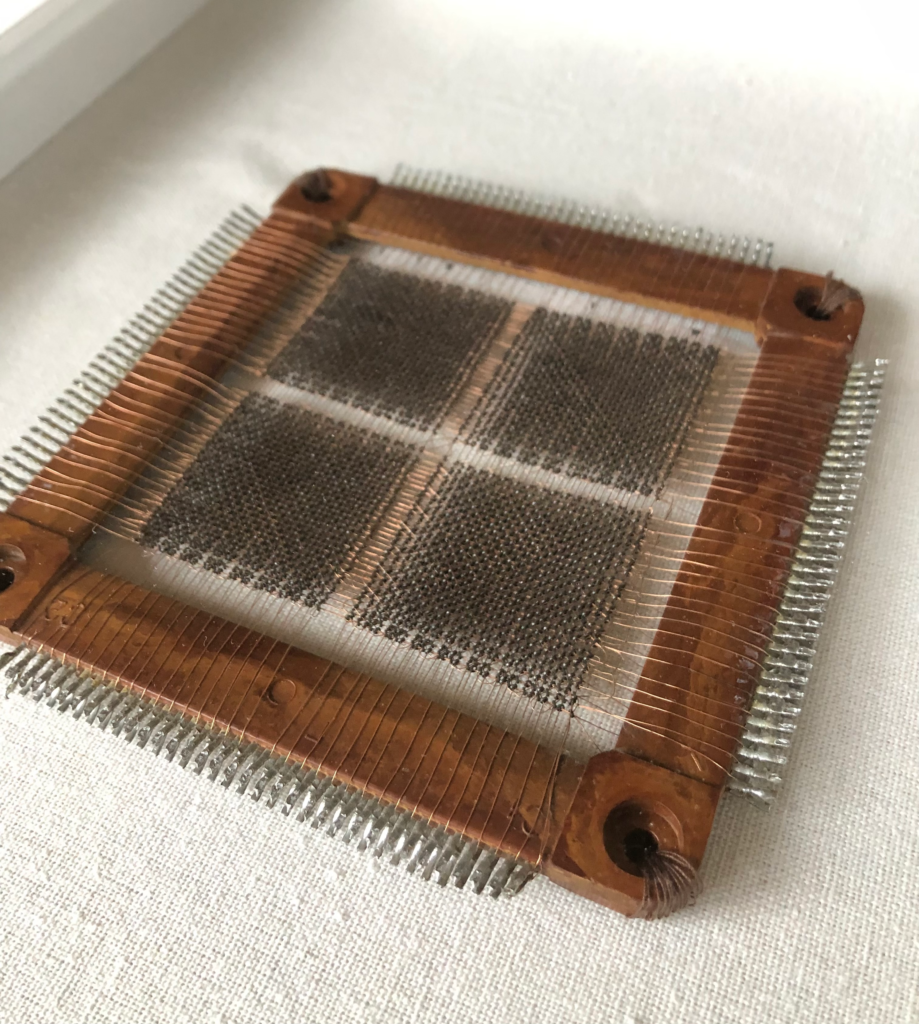
He was right. The object is what is known as a “ferromagnetic core memory,” an antiquated form of computer memory. As I started researching the origin of the object, I learned more about how the histories of computation, memory, textile production, and labor are intertwined.
Core memory was first developed in the 1950s and was the most common type of random-access computer memory until 1975. Random-access memory (RAM) is a type of computer memory that can be accessed at any time, regardless of when it was saved. Core memory works as follows: Wires are tightly laced through small ferrite rings (known as cores). Ferrite is used because it becomes magnetized when exposed to magnetic fields. Electric currents are sent through the wire, which creates magnetic fields. The core can be polarized negatively or positively based on magnetic fields operating in opposite directions (i.e. switching the polarity). Those opposing polarities correspond to 1 or 0, the components that make up bits and bytes.
Weaving core memory
In the United States, the lightweight quality of hand-woven core rope memory, “a technique of physically weaving software into high-density storage,” powered the early Apollo Guidance Computer that put the Apollo on the moon. The history of core rope memory has been well-documented: highly skilled weavers and craft workers, most of whom were women, worked in a Raytheon factory in Waltham, Massachusetts to weave the core rope memory. There was a gendered aspect to this labor: The core rope was referred to as LOL memory (“Little Old Lady” memory). Journalists, engineers, and even a manager at Raytheon allegedly described this work as requiring no thinking and no skill.
The software for flights was managed by a “rope mother” (who was usually male), although Margaret Hamilton, who is best remembered for overseeing the development of the Apollo software, was rope mother on the Luminary.
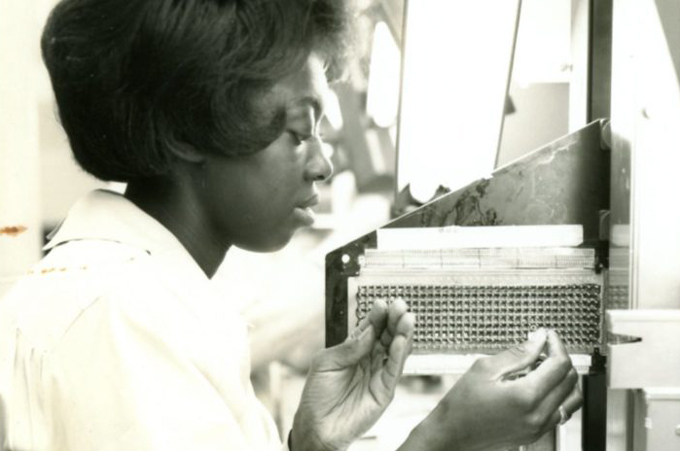
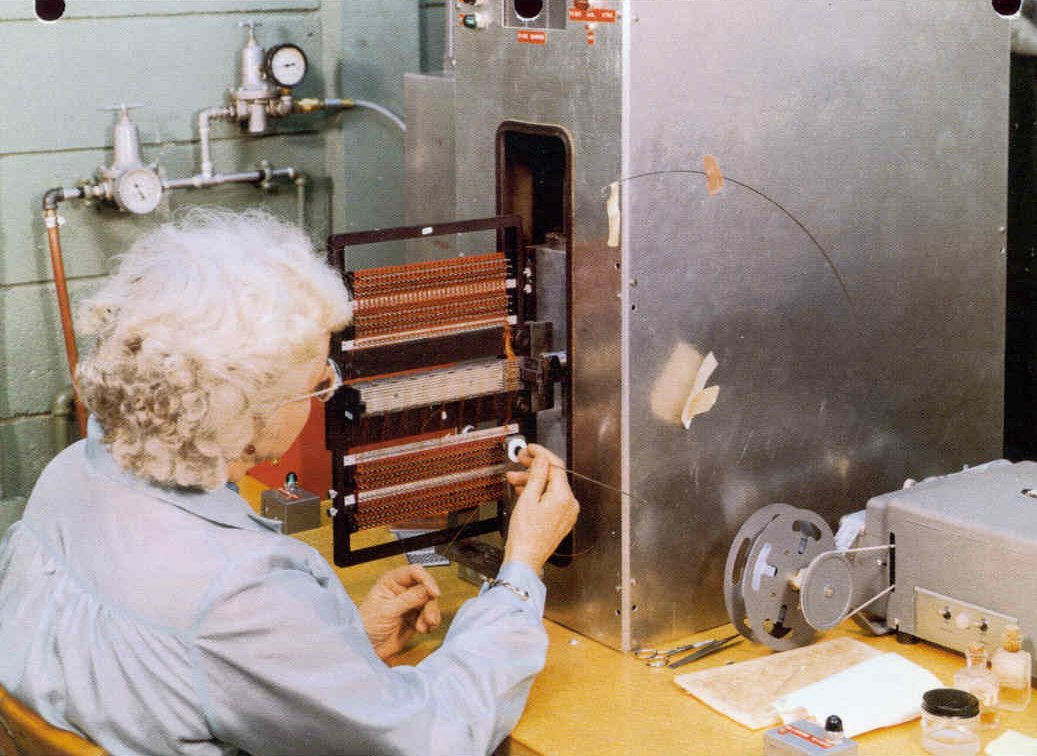
In their paper “Making Core Memory: Design Inquiry into Gendered Legacies of Engineering and Craftwork,” Daniela Rosner and others explore how the high-status, male labor of building computers was powered by low-status craftwork largely carried out largely by women (specifically, women of color). According to Rosner, the work performed at Raytheon was described as “tender loving care” by the man who oversaw the Apollo Guidance Computer’s hardware.
Lisa Nakamura interrogates these ideas in her paper “Indigenous Circuits: Navajo Women and the Racialization of Early Electronic Manufacture”, which looks at the indigenous women who built integrated circuits for the Apollo Guidance Computer. From 1965-1975, the Silicon Valley company Fairchild Semiconductor ran a circuit manufacturing plant in New Mexico on Navajo land where Navajo women were employed. Nakamura demonstrates how racialized notions of labor shaped how value was conferred on the engineering/craftmanship work those Navajo women carried out. According to Nakamura, the work the Navajo women did was described as “affective labor, or a ‘labor of love.’”
The critical contributions of these craftworkers – both the women weaving core memory in MA and the women building integrated circuits in NM – were systematically undervalued and largely erased from computing history until recently. Gendered and racialized notions about what is considered “real” tech work persist today.
The Saratov-2 computer
The ferrite core memory plate I own is a relic of Soviet computing history. The Saratov-2 microcomputer from which my core memory plate is from appears to have been uncovered in the ruins of a fire. Russian urban explorer Ralph Mirebs describes his discovery in a 2020 blog post “Cemetery of Soviet Computers.” Apparently no photos remained of this “legendary machine,” the Saratov-2, until the author came across the ruins. (He declined to share the location). The Saratov-2 is apparently rare enough that no examples were believed to have survived until this discovery.


The Saratov-2 was a clone of the US minicomputer PDP-8/M. Cloning US computers was common practice at the time: In the 1970s, the USSR began getting its hands on PDP minicomputers with the intent of copying them. The PDP-8 was allegedly acquired by the USSR from a sunken US submarine, and then reverse engineered by the Central Research Institute of Measuring Equipment (ЦНИИИА) in the city of Saratov. At least that’s what the Etsy posting says – a blog post written by another computer hobbyist investigates this claim further and can’t confirm it.
What made the Saratov-2 unique was that it didn’t have a microprocessor. Instead, it was broken down into its individual components, which sat in drawers. The ferrite core memory cube, the microcomputer’s RAM, was located in one such drawer.
What about the Saratov-2 core memory plate I own? What handiwork and labor did it require? It’s difficult to say who hand wove the core memory that powered these early microcomputers, since information about them is scant.
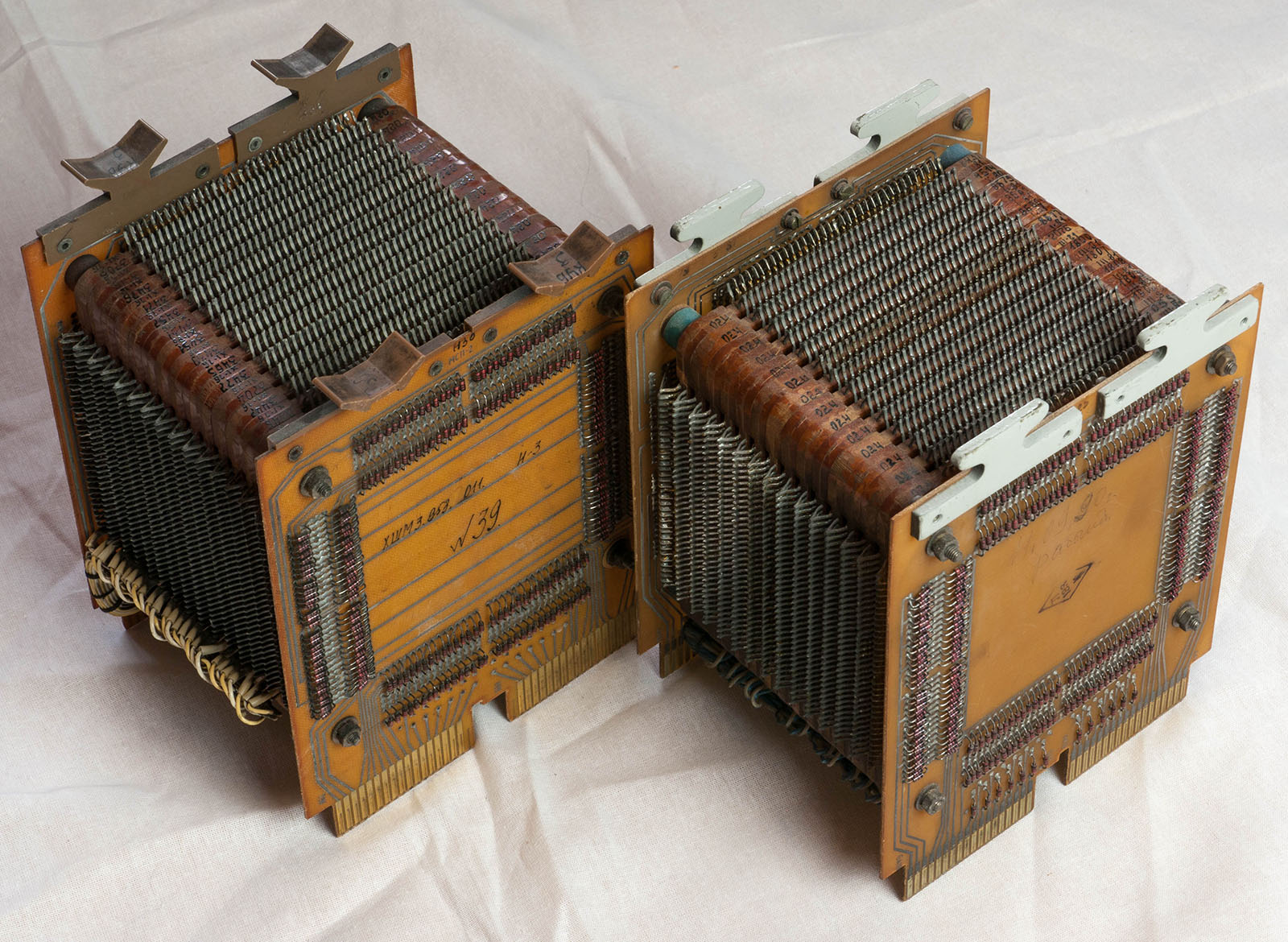
According to Ralph Mirebs (site in Russian), the decimal number on the core memory plate I own begins with KhSHM, which suggests the plate was manufactured at the Central Institute of Measuring Equipment in Saratov, Russia during the 1970s. The Central Institute of Measuring Equipment (TsNIIIA for short) was founded in 1958 and specialized in the manufacturing of electronic devices, including magnetic materials and integrated circuits. This is where the Saratov-2 minicomputer was developed.
I was able to track down the location of the Central Institute of Measuring Equipment. The cluster of TsNIIIA buildings are located at the intersection of Moskovskaya and Radishcheva streets in Saratov, Saratov Oblast, Russia.



The TsNIIIA closed in 1991, and a joint stock company TsNIIIA took its place. In 2017, the owners tried to sell the 32 buildings but failed. In 2021, it was announced the buildings would be turned into a “technocenter.” It’s unclear what the buildings are currently used for.
So, who were the artisans who worked in a TsNIIIA building to weave core memory for the Saratov-2 microcomputers? I’m really not sure. If anyone has more information, I’d love to learn more.
References
Nakamura, Lisa. “Indigenous Circuits: Navajo Women and the Racialization of Early Electronic Manufacture.” American Quarterly, vol. 66, no. 4, 2014, pp. 919–41. DOI.org (Crossref), https://doi.org/10.1353/aq.2014.0070.
Rankin, Joy Lisi. “Core memory weavers and Navajo women made the Apollo missions possible.” Science News. https://www.sciencenews.org/article/core-memory-weavers-navajo-apollo-raytheon-computer-nasa. Accessed 21 Apr. 2022.
Rosner, Daniela. Critical Fabulations: Reworking the Methods and Margins of Design. The MIT Press, 2018.
Rosner, Daniela K., et al. “Making Core Memory: Design Inquiry into Gendered Legacies of Engineering and Craftwork.” Proceedings of the 2018 CHI Conference on Human Factors in Computing Systems, ACM, 2018, pp. 1–13. DOI.org (Crossref), https://doi.org/10.1145/3173574.3174105.
Shorey, Samantha, and Daniela Rosner. “A Voice of Process: Re-Presencing the Gendered Labor of Apollo Innovation.” Communication 1, vol. 7, no. 2, Mar. 2019, https://doi.org/10.7275/yen8-qn18.
“Software Woven into Wire: Core Rope and the Apollo Guidance Computer.” http://www.righto.com/2019/07/software-woven-into-wire-core-rope-and.html. Accessed 14 Jan. 2022.
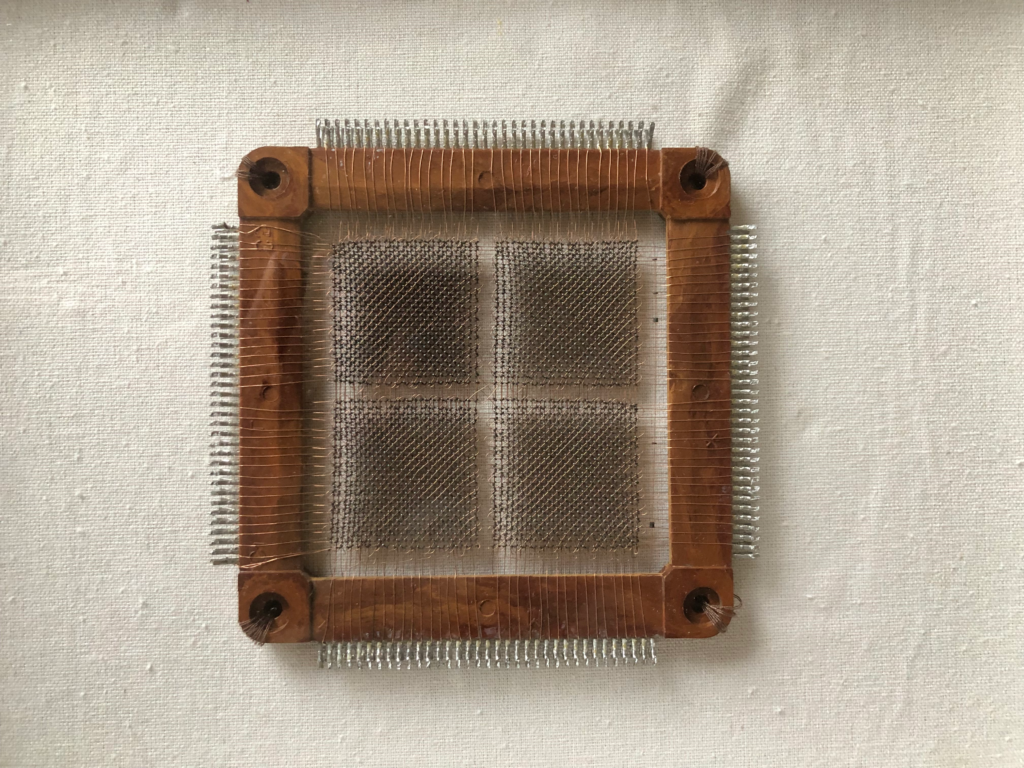
I also have one of those core memory plates from a Saratov-2 computer.
I was lucky to buy mine back in January 2020 direct from a Russian eBay seller.
As you state the Saratov-2 was a Soviet clone of a western DEC PDP-8 mini-computer.
For actual use 14 plates were assembled into a stack to form a “Core Memory Cube”
Each cube with its attached diode plates is approximately 6 inches square.
12 plates stored actual data and the extra 2 were used for parity checking (to detect error bits)
The Saratov-2 was a 12-bit computer – that is each data item or command was 12-bits long.
The smallest discrete item is a 12-bit word that can be written or read into or out of memory.
The reason the cube was required was that these 12-bit words were written vertically down through the stack – that is each 12-bit word was stored as one bit on each plate vertically down through the cube. While this may at first seem odd it allows you to write the whole 12-bit word in one operation – which you couldn’t do if all 12-bits were stored on a single plate.
Each plate holds plate has 4096 cores (aka bits) – which in modern terminology equates to 512 Bytes or ½KB (@ 8bits per byte). The data capacity of a Cube is 12x(4096 bits) – aka 4096 twelve-bit words – and equates to 6KB in modern terminology. The standard configuration was to have 8 memory cubes in each Saratov-2 minicomputer – 8 cubes would hold just 48KB of data.
The Apollo spacecraft and the Saturn V rocket all used core memory – as even by the late 1960’s silicon memory chips have yet to be invented. Here are two links regarding Apollo memory. The eraseable core http://www.youtube.com/watch?v=uyxQmb2u6Hk&t=146s
and the read-only rope core http://www.youtube.com/watch?v=2qe4W_USweE&t=66s